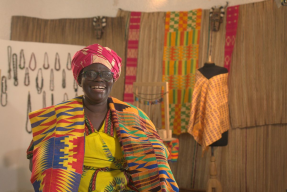
By Nadia Anggraini, KF10
My butt (pardon the language) was hurting from hours of riding pillion on my MFI field officer’s motorbike, my lungs were working overtime to dispel toxic fumes emitted by the large trucks on the roads, and my heart was still recovering from multiple seizures from dodging kids, dogs, chicken and other random objects dashing across the streets. We were on hour four of a field visit, and we had visited a total of…three borrowers.
Having lived in a country that worships productivity for the past four years, I was starting to feel somewhat concerned. How can field officers visit only a handful of clients each day, and instead spend all their time on the roads, traversing the great distances between the various villages? Can I find a way to make this more efficient?
I ruminated about this issue for awhile, and my thought process was as follows: To reduce traveling time between borrowers’ homes à find concentrated areas of borrowers à so why not…work more in cities instead of villages????? After all, not only do cities contain a ripe, concentrated and underserved market of the entrepreneurial poor, they’re also growing rapidly in Indonesia, a developing country with a high urbanization rate. Sounds like the perfect place for an MFI right?
…that’s what I thought, until I asked some of the field officers at my MFI, Koperasi Mitra Usaha Kecil (MUK) about this. Obviously, MUK is ten steps ahead of me and is already operating in cities, but the field officers actually told me they preferred working in rural areas to urban ones. The field officers told me that it is much more difficult to collect repayments from the urban poor compared with the rural poor, and at MUK, the default rate for the rural poor stood at a pristine 0%, versus a shocking 20% for the urban poor before MUK implemented a collateral requirement, and 6% after. They gave two main explanations for this phenomenon:
1) Migratory nature of the urban poor: The urban poor are often villagers who have temporarily moved to the city for work. They rent rooms in homestays in the city, and can pack up easily and disappear to avoid making their payments, forcing the poor field officers to go on many a wild’s goose chase to trace these borrowers’ whereabouts. Some are even migrants from surrounding islands such as Java and Lombok, and do not have strong ties to Bali.
In contrast, the rural poor generally own the land they live in, and would not move, even if they cannot make their payments.
2) Urban poor are less bound by custom: Balinese villages are strongly and deeply bound by adat (custom). Villagers look up to and listen to their village heads, and do not disobey the rules of the village. When field officers visit a new village, they first go to the village head to obtain his blessings before promoting MUK’s loan programs to the villagers. As such, these loan programs are village-wide endeavors endorsed by the village head, and borrowers are often disinclined to miss their payments, seeking instead various means to prevent this from happening (whether this is a good or bad thing is a different question altogether).
On the other hand, urban borrowers are not bound by similar social rules, and may thus not treat delinquency with the same level of seriousness.
What, then, are the implications for microfinance? Does it mean that microfinance works better in the countryside, and that MFIs should focus on serving villagers instead of city dwellers? Some cursory research (read: Googling) seem to indicate otherwise though – it seems that some organizations have found success serving urban markets. I’d have to dig in a lot deeper to figure out what exactly makes it tick for these organizations, and how MUK can adapt its current urban microfinance model become more effective, but in the meantime I just wanted to share this newfound knowledge recently gleaned from my MFI in the field.
Nadia Anggraini is a member of the 10th class of Kiva Fellows. She is currently serving her placement at Koperasi Mitra Usaha Kecil in Bali, Indonesia. Consider joining our new lending team, or fund a loan on the Kiva website!
PREVIOUS ARTICLE
I didn’t know “model” was in my job description →NEXT ARTICLE
Helping Haiti: Microfinance and Disaster Relief →













